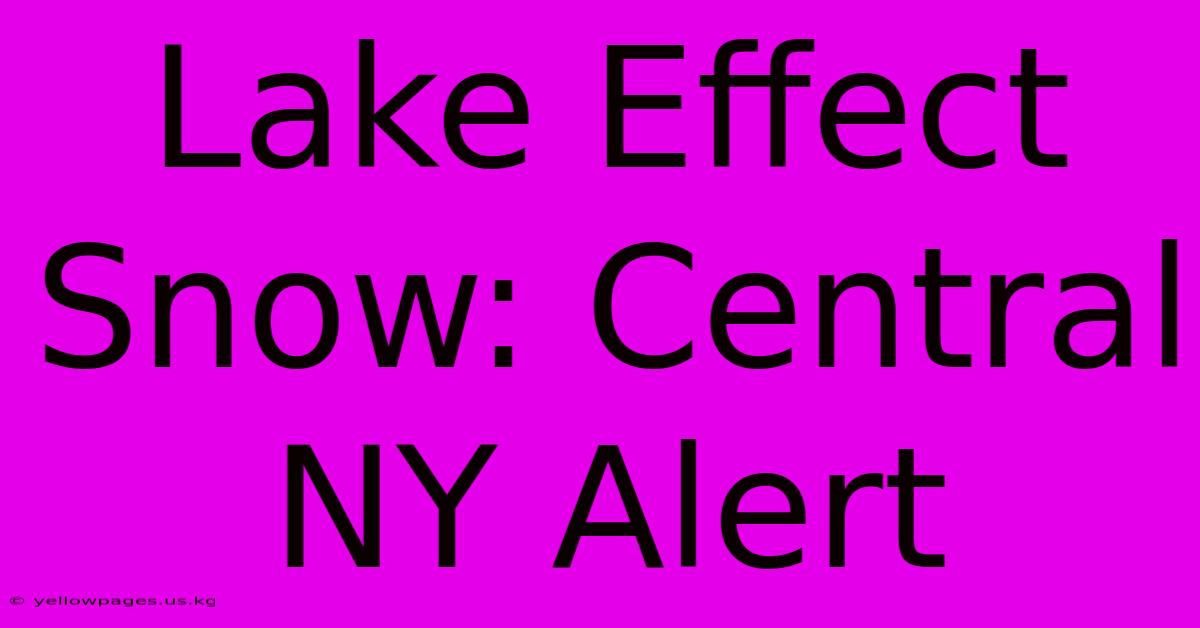Lake Effect Snow: Central NY Alert

Discover more detailed and exciting information on our website. Click the link below to start your adventure: Visit Best Website trendingnews.us.kg. Don't miss out!
Table of Contents
Lake Effect Snow: Central NY Alert
Central New York residents need to be prepared. We're talking lake-effect snow, and this isn't your average winter flurry. This phenomenon can bring blizzard conditions, crippling travel, and significant disruptions to daily life. Understanding what causes lake-effect snow, how to prepare, and where to find reliable information is crucial for staying safe and informed this winter.
What is Lake-Effect Snow?
Lake-effect snow is a weather phenomenon that occurs when cold, dry air masses move across relatively warm lake waters. As the air passes over the lake, it picks up moisture and warmth. This moisture-laden air then rises, cools, and condenses, forming clouds. These clouds produce significant snowfall, often concentrated in narrow bands downwind of the lake. The effect is amplified by several factors, including:
- Temperature Difference: The greater the temperature difference between the cold air and the relatively warmer lake water, the more intense the snowfall.
- Wind Direction and Speed: Prevailing winds play a critical role. They determine where the snow bands will form and how much snow falls in a particular area. Stronger winds can lead to heavier snowfall.
- Lake Size and Depth: Larger and deeper lakes hold more heat and moisture, leading to more prolonged and intense lake-effect snow events.
Central New York's proximity to Lake Ontario makes it particularly vulnerable to these intense snowstorms.
Why Central NY is at Risk
Central New York's geographic location, situated downwind of Lake Ontario, places it squarely in the path of frequent and sometimes devastating lake-effect snow events. The lake's large size and depth provide ample moisture, while the prevailing winds often carry this moisture-laden air directly over the region. This combination creates a perfect storm – literally – for heavy snowfall accumulations.
Preparing for Lake-Effect Snow in Central NY
Being prepared is key to minimizing the risks associated with lake-effect snow. Here's a checklist:
- Emergency Kit: Stock up on essential supplies, including non-perishable food, water, blankets, flashlights, batteries, a first-aid kit, and medications.
- Vehicle Preparedness: Keep your car's gas tank full, carry a winter emergency kit (jumper cables, shovel, ice scraper, etc.), and check your tire pressure and tread depth. Consider carrying extra warm clothing.
- Stay Informed: Monitor weather forecasts closely from reputable sources like the National Weather Service. Pay attention to winter weather advisories, warnings, and watches. Sign up for emergency alerts from your local authorities.
- Home Safety: Ensure your home is properly insulated and that you have a backup power source if necessary. Clear gutters and downspouts to prevent ice dams.
- Travel Safety: Avoid unnecessary travel during lake-effect snow events. If you must travel, inform someone of your route and expected arrival time. Drive slowly and cautiously.
Staying Safe During a Lake-Effect Snowstorm
During a lake-effect snowstorm:
- Stay Indoors: Unless absolutely necessary, stay home and avoid travel.
- Conserve Energy: If a power outage occurs, conserve energy to extend the life of your backup power source.
- Check on Neighbors: Check on elderly or vulnerable neighbors to ensure their safety and well-being.
- Be Aware of Cold Weather Dangers: Hypothermia and frostbite are serious risks during prolonged cold and snowy conditions. Dress warmly in layers and be aware of the symptoms of these conditions.
Reliable Resources for Central NY Lake-Effect Snow Information
Several reliable resources provide up-to-date information on lake-effect snow in Central New York:
- National Weather Service (NWS): The NWS provides detailed forecasts, warnings, and advisories.
- Local News Media: Local television and radio stations typically provide frequent updates during severe weather events.
- NY State Emergency Management Office: Check their website for emergency preparedness information and alerts.
Lake-effect snow in Central New York is a serious weather phenomenon that requires careful preparation and vigilance. By understanding the risks and taking proactive steps, you can help protect yourself and your family. Stay informed, stay safe, and stay prepared.

Thank you for visiting our website wich cover about Lake Effect Snow: Central NY Alert. We hope the information provided has been useful to you. Feel free to contact us if you have any questions or need further assistance. See you next time and dont miss to bookmark.
Featured Posts
-
Michigan Beats Alabama Highlights Score
Jan 01, 2025
-
New Years Eve Blackout Hits Puerto Rico
Jan 01, 2025
-
Fort Myers Open Businesses New Years Day 2025
Jan 01, 2025
-
Bedards 2025 Nhl Winter Classic Debut
Jan 01, 2025
-
Brangelina Split Years Of Legal Battles
Jan 01, 2025
